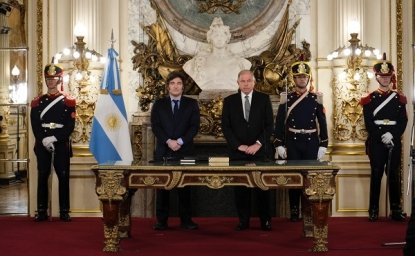Q: Over the last month, Latin America has been rocked by massive protests in Ecuador, Bolivia and, unexpectedly, Chile. The sudden and violent demonstrations in Chile were surprising to many observers, and called into question Chile’s position as the “model” for Latin American economic and political governance. The trigger for the protests was a modest increase in transit fares that ignited a tinderbox of grievances. Several observers (see here and here, for example) have explained the protests by pointing to a “middle class [that] feels abandoned.” Were you surprised by the protests? Do you agree the protests largely reflect middle-class grievances concerning low social mobility and the high cost of living, or are there other explanations?
A: For many Chileans, and for those who follow the country’s politics closely, the discontent expressed by protestors is not altogether surprising. The country has seen growing protests since 2011, and the 2017 election revealed an electorate frustrated with political parties and the political system more broadly. For me, what stood out is how popular the protest movement is, how ineffective the political response has been, and the deeply troubling human rights violations.
Following Chile’s return to democracy in 1990, the country witnessed high and sustained growth rates and low inflation. In this setting of macroeconomic stability, poverty declined precipitously, but levels of income inequality remained stubbornly high. Beginning in the early 2000s, inequality became an important point of political conflict, as it coincided with a rising cost of living, generating deep frustration. At the same time, younger generations insisted on a more participatory form of politics, taking to the streets to demand a more egalitarian education system. The country’s traditional center-left parties – the Socialists, Christian Democrats and the Party for Democracy – ignored these demands. As frustrations mounted, young Chileans turned to the Communist Party, or formed new parties. Chile’s right-wing parties have also been deaf to popular demands, seeking to repress protest rather than engage in dialogue and negotiation.
The 2017 election heightened this conflict. While the electorate did not turn to the right, a coalition of conservative parties won the presidency. This was possible thanks to divisions on the left between the traditional parties and newcomers. The results laid bare that Chile’s party system is incapable of providing effective representation. The election revealed a polarized electorate with a strong leftward orientation, but one that has lost faith in political parties. I believe this combination pushed politics onto the streets, and helps explain why elites and the state have had such a difficult time responding to the mobilization.
Q: Chile is seen as an exemplar of neoliberal policies in the region, with the private sector playing a central role in the provision of public services, such as pensions and health care. These policies are often credited with increasing economic growth and macroeconomic stability, but they have also been criticized for stratifying access to critical services and worsening inequality. Although poverty and income inequality are at all-time lows, public frustration is growing. A long-standing area of tension is education. Chile has seen massive student protests under both left- and right-leaning governments, with student leaders driving the national conversation, and changing the face of Chilean politics. Indeed, high school students started the recent outbreak of protests. What are the main grievances of Chile’s youth, and why is the education system so controversial? What role do student organizations play in Chilean politics?
A: The grievances of Chilean youth are multiple and vary across income, regions and sexes. In 2006, but picking up in 2011, we saw the emergence of a strong student movement that pushed for reforms to Chile’s primary, secondary and post-secondary education systems. Demands included universal, free and high-quality public education.
Chile’s education system was overhauled by the Pinochet dictatorship. In 1980, the junta decentralized the administration of primary and secondary schools and altered the system that finances education. Under the new model, Chile transitioned to a nationwide school voucher program. The state was required to provide a per-pupil, per-day-attended payment that parents could opt to use for attendance at a public (municipal) school or a subsidized private school. The reform did not regulate subsidized private schools, which were permitted to charge a co-payment and establish admissions criteria. The result was further segmentation in the provision of education and declining funding for public schools. Municipalities struggled to provide high-quality education because of funding constraints and limited local-level state capacity. As a result, inequality between public and private education widened. The democratic governments of the 1990s and early 2000s increased spending on education, but did little to alter the overall structure of the system, including the demand-side financing mechanism. Under pressure from student mobilization, reforms created a differentiated subsidy, better regulated subsidized private schools and eliminated admissions requirements. Still, public municipal schools continue to lag behind in student performance.
The dictatorship also reduced public spending on education and deregulated post-secondary services, facilitating the creation of private universities and limiting rules that governed their operation. Tuition grew quickly, and as enrollment rose during the 1990s and early 2000s, many families found themselves in debt and graduates struggled to find work. This contributed to the intense student protests in 2011. During President Michelle Bachelet’s second administration (2014 to 2018), Chile approved a law guarantying a free university education for some needy students. Many protestors found the measure to be insufficient, insisting that the benefit does not cover the full cost of schooling and that many students were left out
Since 2011, we’ve also seen growth in feminist student mobilization. Building on the #NiUnaMenos movement, feminists have mobilized to demand protections against sexual harassment and sexual assault on campus, and also in the workplace. Last March, an estimated 800,000 citizens took to the streets of Santiago in honor of international women’s day, led by student organizations. It is clear that students have been an important force behind growing protests and are often the first groups to call people to the streets, with large swaths of society supporting their actions.
Q: Although Chile has seen mass protests in the past, the current demonstrations took an exceedingly violent turn, with 15 people reported dead. President Sebastián Piñera imposed, for the first time since the return to democracy, a state of emergency unrelated to a natural disaster, and implemented a curfew. At the height of the tension, Mr. Piñera said, “we are at war against a powerful enemy, who is willing to use violence without any limits.” Implying the protests were not spontaneous, he alleged “a degree of organization, logistics, typical of a criminal organization.” Since then, the president appears to have walked back these controversial statements, and he apologized for “problems accumulated for many decades, and that different governments were not able to recognize this situation in all its magnitude.” He also announced measures to increase wages and pensions, reduce living costs and advance political reforms. Why did the president so dramatically change his tone? Will his newly announced redistributive policies be enough to stem popular anger?
A: President Piñera’s response to the protests provides insight into the character of Chile’s conservative parties and the country’s political class more broadly. The militarized reaction, which has resulted in an alarming number of human rights abuses, reveals that the right still sees coercion and not democratic debate and negotiation, as a solution to social demands. The president’s response also showed that the parties of the right, or at least sectors of those parties, are out of touch with the country’s historical memory. For many Chileans, seeing the military patrolling the streets and repressing protest evokes terrifying and traumatic memories of the dictatorship. That Piñera did not worry about that reaction reveals a deep disconnect with citizens.
The president’s change of tone reflected a realization – one that came too late – that the protests are rooted in deep and broad discontent over Chile’s economic, social and political systems, and that the protestors and their demands were not simply going to fade from the national stage. His response, however, was insufficient. His reforms call for a relatively small adjustment in spending, but protestors are looking for deeper structural reform. While the demands are diverse, a common thread among participants is a desire for a new social and political pact. Such a process would have to involve rethinking the private sector’s role in education, health and pensions, and a serious discussion of constitutional reform.
Q: Your research on Latin American party systems describes Chile’s party system as consisting of “electoral-professional” parties with a “top-down approach to social policy” and relatively weak links with civil society. You have observed that a consequence of this structure is that Chile’s political parties “consistently fall short of creating fully universalistic systems of social protection.” What makes Chile’s party system unique in Latin America? Is the current wave of violence a result of the distance between Chile’s political parties and its civil society?
A: Like other countries in the region, Chile underwent a “left turn” in 2000 with the election of Socialist President Ricardo Lagos (2000 to 2006), followed by Socialist President Michelle Bachelet (2006 to 2010 and 2014 to 2018). Chile’s “pink tide” produced important social gains, including reforms to the education, health and pension systems, as well as increases to the minimum wage. Still, the center-left coalition – the Concertación – failed to take up demands for structural reforms to the country’s economic and social systems, remaining wedded to the neoliberal model. The center-left coalition was able to resist these calls for reform because the parties engaged in a top-down, elitist form of policymaking that insulated politicians from popular demands. This model worked in the early years of democracy because political competition centered around the legacies of Pinochet’s dictatorship. As those concerns faded, however, so too did the ability of Chile’s center-left parties to represent public opinion.
This is one of the key reasons protestors took to the streets, but it is also a reason why the state has had such a difficult time calming the situation. Chile’s political parties and its party system have been described as strong and deeply institutionalized by multiple scholars. Despite this fact, they exhibit very weak ties to society. This makes it hard for politicians to effectively gauge public opinion, but also for citizens or social organizations to access the political arena and participate in debate and policymaking. In moments of crisis, like the one Chile is facing, political parties are an essential actor, as they have the ability to call social groups to the table and channel demands. The fact that Chile’s parties have eroded their capacity to undertake this task has made it very hard for politicians to respond to the mobilization. The elitist character of the countries parties has also undermined citizen trust, which further curtails their ability to play a constructive role in responding the ongoing unrest.
Author


Argentina Project
The Argentina Project is the premier institution for policy-relevant research on politics and economics in Argentina. Read more


Latin America Program
The Wilson Center’s prestigious Latin America Program provides non-partisan expertise to a broad community of decision makers in the United States and Latin America on critical policy issues facing the Hemisphere. The Program provides insightful and actionable research for policymakers, private sector leaders, journalists, and public intellectuals in the United States and Latin America. To bridge the gap between scholarship and policy action, it fosters new inquiry, sponsors high-level public and private meetings among multiple stakeholders, and explores policy options to improve outcomes for citizens throughout the Americas. Drawing on the Wilson Center’s strength as the nation’s key non-partisan policy forum, the Program serves as a trusted source of analysis and a vital point of contact between the worlds of scholarship and action. Read more

Explore More
Browse Insights & Analysis
Uphill Battle for Argentina’s Feminists

¡Afuera! Milei Puts his Stamp on Argentine Diplomacy


